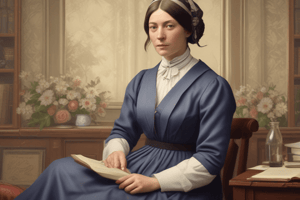Podcast
Questions and Answers
What does statistics depend upon according to Florence Nightingale?
What does statistics depend upon according to Florence Nightingale?
The practical application of every other science and art.
In what sense is statistics defined in its singular form?
In what sense is statistics defined in its singular form?
- A branch of science (correct)
- Only applicable in business
- Related only to social sciences
- A set of numerical data
Statistics is used only for social sciences.
Statistics is used only for social sciences.
False (B)
What is one role of statistics in biological and medical sciences?
What is one role of statistics in biological and medical sciences?
Which of the following is NOT a major area of statistics?
Which of the following is NOT a major area of statistics?
What is the main concern of Descriptive Statistics?
What is the main concern of Descriptive Statistics?
What distinguishes Inferential Statistics from Descriptive Statistics?
What distinguishes Inferential Statistics from Descriptive Statistics?
Flashcards are hidden until you start studying
Study Notes
Florence Nightingale's View on Statistics
- Considered statistics the most important science, essential for the application of all other sciences and arts.
- Emphasized statistics as crucial for political, social administration, and education.
- Suggested that understanding statistics is akin to understanding divine purpose.
Definition of Statistics
- In plural: Refers to numerical data sets (e.g., beauty contest vital statistics, monthly sales).
- In singular: Defined as a science dealing with data collection, presentation, analysis, and interpretation.
General Uses of Statistics
- Aids in decision-making processes by providing comparisons and justifications.
- Explains past actions and predicts future outcomes.
- Estimates unknown quantities while summarizing data for public utility.
Application of Statistics
- Grown significantly in the 20th century, influencing diverse fields such as education, agriculture, economics, biology, and medicine.
- Increasingly relevant in hard sciences like astronomy, geology, and physics.
Role of Statistics in Various Fields
- Biological and Medical Sciences: Aids in discovering variable relationships and evaluating treatment effectiveness.
- Example: Analyzing the relationship between blood pressure increases and age.
- Social Sciences: Supports empirical research to formulate new socio-political theories.
- Example: Developing a socio-economic profile of the middle class.
- Business: Facilitates sales forecasting, product design, and efficiency in production.
- Example: Using statistical analysis to determine the effectiveness of a new pharmaceutical formula.
- Engineering: Tests material properties for quality control purposes.
- Example: Estimating product lifespan based on current equipment.
Fields of Statistics
- Applied Statistics: Involves techniques for data collection, presentation, analysis, and interpretation.
- Mathematical Statistics: Focuses on developing theories that underpin statistical methods.
Major Areas of Statistics
-
Descriptive Statistics:
- Concerned with summarizing and analyzing data without making wider inferences.
- Aims to present data clearly.
- Conclusions apply only to the specific dataset.
- Example: Graphing census data by age and sex in the Philippines or presenting honor roll statistics at universities.
-
Inferential Statistics:
- Involves making predictions or inferences about a larger population based on a sample.
- Focuses on predicting and drawing conclusions from the data.
- Conclusions are generalizable beyond the sample.
- Example: Testing a new milk formula on a sample of infants to assess developmental impact.
Florence Nightingale's View on Statistics
- Considered statistics the most important science, essential for the application of all other sciences and arts.
- Emphasized statistics as crucial for political, social administration, and education.
- Suggested that understanding statistics is akin to understanding divine purpose.
Definition of Statistics
- In plural: Refers to numerical data sets (e.g., beauty contest vital statistics, monthly sales).
- In singular: Defined as a science dealing with data collection, presentation, analysis, and interpretation.
General Uses of Statistics
- Aids in decision-making processes by providing comparisons and justifications.
- Explains past actions and predicts future outcomes.
- Estimates unknown quantities while summarizing data for public utility.
Application of Statistics
- Grown significantly in the 20th century, influencing diverse fields such as education, agriculture, economics, biology, and medicine.
- Increasingly relevant in hard sciences like astronomy, geology, and physics.
Role of Statistics in Various Fields
- Biological and Medical Sciences: Aids in discovering variable relationships and evaluating treatment effectiveness.
- Example: Analyzing the relationship between blood pressure increases and age.
- Social Sciences: Supports empirical research to formulate new socio-political theories.
- Example: Developing a socio-economic profile of the middle class.
- Business: Facilitates sales forecasting, product design, and efficiency in production.
- Example: Using statistical analysis to determine the effectiveness of a new pharmaceutical formula.
- Engineering: Tests material properties for quality control purposes.
- Example: Estimating product lifespan based on current equipment.
Fields of Statistics
- Applied Statistics: Involves techniques for data collection, presentation, analysis, and interpretation.
- Mathematical Statistics: Focuses on developing theories that underpin statistical methods.
Major Areas of Statistics
-
Descriptive Statistics:
- Concerned with summarizing and analyzing data without making wider inferences.
- Aims to present data clearly.
- Conclusions apply only to the specific dataset.
- Example: Graphing census data by age and sex in the Philippines or presenting honor roll statistics at universities.
-
Inferential Statistics:
- Involves making predictions or inferences about a larger population based on a sample.
- Focuses on predicting and drawing conclusions from the data.
- Conclusions are generalizable beyond the sample.
- Example: Testing a new milk formula on a sample of infants to assess developmental impact.
Studying That Suits You
Use AI to generate personalized quizzes and flashcards to suit your learning preferences.




